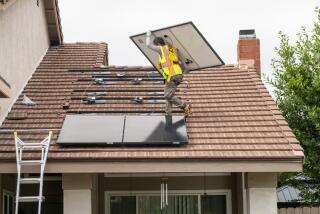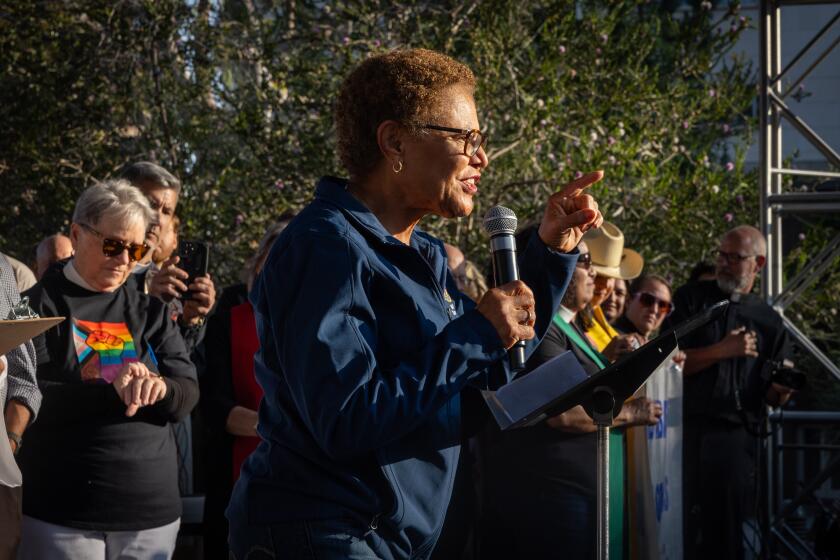Contrasting shades of green
- Share via
SACRAMENTO — At the State Capitol, boosting the use of solar power, wind generators and other renewable energy sources is seen as a boon for both the environment and the economy in electricity-hungry California.
But with two weeks left in the legislative session, Democrats are hustling to fulfill a commitment they made to Gov. Arnold Schwarzenegger to pass a law to require all utilities to get a third of their power from “green” sources by 2020.
Meeting that pledge isn’t easy, and a fight is brewing about just how fast the state can go green and how to accomplish it.
The dispute centers on the utilities’ slow pace in meeting the existing goal of 20% for 2010 -- spelled out by a law passed in 2006 -- and on how to craft a longer-range plan that hits Schwarzenegger’s more ambitious target.
On one side of the sharp debate are environmentalists, labor unions, Democratic legislators and consumer advocates. Electric utilities and business lobbies are on the other, while the governor appears to have a foot in each camp.
The main argument is over how much of the new green power must be generated within California’s borders. Another point of contention is which is more expensive: in-state renewable energy or wind and solar power from facilities elsewhere in the West.
The complex, many-sided negotiations could have a big effect in the decade ahead on consumers’ electric bills, the quality of the air they breathe and the effect of global warming on their communities.
Schwarzenegger, who has garnered an international reputation for making California a leader in the fight against global warming, stressed that an increasing investment in renewable energy “will help us fight climate change while driving our state’s green economy.”
The discussion about requirements for 2020 is marred by the fact that the state’s utilities are woefully behind in meeting a legal deadline of obtaining 20% of their power from renewable resources by 2010.
As of 2008, Southern California Edison Co. posted 15.5%, Pacific Gas & Electric Co., 11.9% and San Diego Gas & Electric Co. only 6.1%, according to the California Public Utilities Commission.
The three companies aren’t expected to hit 20% until at least 2013.
The utilities say they’ve been hampered by delays in getting transmission lines licensed and built in California so they can bring wind, solar and geothermal power from remote desert and mountain areas to population centers along the coast.
Nevertheless, they say that they will have enough power under contract to reach the 33% goal by 2020 -- if lawmakers and regulators give them rules that provide plenty of flexibility.
For example, last month PG&E; announced plans to buy solar power from a generator in Boulder City, Nev. And this month, Edison said it would partner with an Arizona company to build two large solar plants in Riverside and San Bernardino counties.
This year’s battle in Sacramento involves two related bills, SB 14 by state Sen. Joe Simitian (D-Palo Alto) and AB 64 by Assemblyman Paul Krekorian (D-Burbank). The Simitian bill is on the floor of the Assembly, and the Krekorian measure is on the floor of the Senate.
Unlike the current 20% renewable energy law for 2010, the two proposed bills with goals for 2020 have enforcement provisions, including financial penalties for failing to meet renewable energy procurement levels.
They also broaden the requirements to include publicly owned utilities, such as the Los Angeles Department of Water and Power.
Simitian, who is pushing for the 33% requirement, said he wants to “find a sweet spot” that he says would keep electricity rates reasonable, protect the environment and not saddle businesses with uneconomical or burdensome regulations.
“This is very heavy lifting,” he conceded.
A big sticking point in the debate is how much renewable power the state’s utilities are allowed to buy or generate out of state. The current law has no limit.
The utilities favor that, but labor unions and their allies want a provision in pending legislation that at least 80% of the power be generated in California.
Unions and their supporters say that most of the new power plants should be built in state so that California workers could snag most of the new green jobs and other benefits involved. “If the people of Wyoming receive the jobs, the tax revenue and the infrastructure, what benefit are Californians going to get other than higher electric bills?” said Matt Freedman, an attorney with the Utility Reform Network, a ratepayers’ group. “The question is, ‘Who is going to benefit from the 33% standard?’ ”
Utilities and business groups disagree. They say that limiting imports of out-of-state power would keep California from buying often-cheaper renewable energy available across the region.
A proposed limit on imported green power could spur higher retail prices for business customers that use a lot of electricity, such as factories and big-box retail stores, utility executives contend.
California businesses already pay some of the highest electricity rates in the country, according to the Energy Information Administration, a federal agency.
What’s more, utilities argue that the entire Western electricity grid is so interconnected that putting restrictions on where generators are located would drive up costs.
“It’s basic economics,” said Stuart Hemphill, vice president of renewable procurement for Southern California Edison. “You’re increasing demand for a product. If you don’t also increase the supply, you’re going to have the potential for increased prices.”
H. David Nahai, general manager of the Los Angeles DWP, dismissed the 20% limit on out-of-state power as “wholly insufficient.”
Environmental groups are hoping to reach a compromise with the utilities over the out-of-state controversy. “It’s not a black-and-white answer,” said Sheryl Carter, co-director of energy programs for the Natural Resources Defense Council.
What’s important, environmentalists say, is putting a higher target in place soon so that utilities have enough time to develop wind, solar and geothermal power sources.
“You need to put a new target because the utilities work on a 10-year cycle for procurement,” said Jim Metropulos, a Sierra Club lobbyist. “They need a goal because they are not going to do it on their own.”
--
(BEGIN TEXT OF INFOBOX)
A green push
Gov. Arnold Schwarzenegger wants California to have the country’s most ambitious standard for using wind, solar and other renewable energy sources. He’s pushing the state’s electric utilities to get 33% of their power from “green” sources by 2020, and the Legislature is considering two bills to put that goal into law. The state’s three investor- owned utilities say they can meet the goal if they are given enough flexibility. But for now they’re having trouble hitting the current goal of generating 20% of their power from green sources by 2010. Here’s how they were doing as of 2008.
* Southern California Edison Co.: 15.5%
* Pacific Gas & Electric Co.: 11.9%
* San Diego Gas & Electric Co.: 6.1%
Source: California Public Utilities Commission
More to Read
Get the L.A. Times Politics newsletter
Deeply reported insights into legislation, politics and policy from Sacramento, Washington and beyond. In your inbox twice per week.
You may occasionally receive promotional content from the Los Angeles Times.











